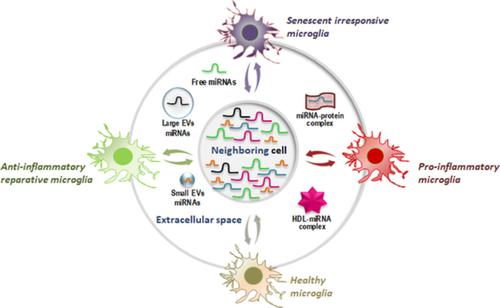Our official English website, www.x-mol.net, welcomes your feedback! (Note: you will need to create a separate account there.)
Regulatory function of microRNAs in microglia.
Glia ( IF 6.2 ) Pub Date : 2020-05-28 , DOI: 10.1002/glia.23846 Dora Brites 1, 2
Glia ( IF 6.2 ) Pub Date : 2020-05-28 , DOI: 10.1002/glia.23846 Dora Brites 1, 2
Affiliation

|
Microglia are CNS‐resident cells involved in immune surveillance and maintenance of intercellular homeostasis, while also contributing to neurologic pathologies. MicroRNAs (miRNAs) are a class of small (~22 nucleotides) single‐stranded noncoding RNAs that participate in gene regulation at the post‐transcriptional level. miRNAs typically bind to the untranslated region (3′ UTR) of RNAs. It has been shown that miRNAs are important players in controlling inflammation and that their abnormal expression is linked to cancer and ageing, and to the onset and progression of neurodegenerative disease. Furthermore, miRNAs participate in intercellular trafficking. Thus, miRNAs are released from cells in a free form, bound to proteins or packaged within extracellular vesicles (EVs), exerting paracrine and long distance signaling. In this review, recent findings on the role of miRNAs as drivers of microglia phenotypic changes and their cotribution in neurological disease are addressed.
中文翻译:

microRNAs 在小胶质细胞中的调节功能。
小胶质细胞是 CNS 驻留细胞,参与免疫监视和维持细胞间稳态,同时也有助于神经病理学。MicroRNA (miRNA) 是一类小的(~22 个核苷酸)单链非编码 RNA,参与转录后水平的基因调控。miRNA 通常与 RNA 的非翻译区 (3' UTR) 结合。已经表明,miRNA 是控制炎症的重要参与者,它们的异常表达与癌症和衰老以及神经退行性疾病的发生和进展有关。此外,miRNAs 参与细胞间运输。因此,miRNA以游离形式从细胞中释放出来,与蛋白质结合或包装在细胞外囊泡(EV)中,发挥旁分泌和长距离信号传导。在这次审查中,
更新日期:2020-05-28
中文翻译:

microRNAs 在小胶质细胞中的调节功能。
小胶质细胞是 CNS 驻留细胞,参与免疫监视和维持细胞间稳态,同时也有助于神经病理学。MicroRNA (miRNA) 是一类小的(~22 个核苷酸)单链非编码 RNA,参与转录后水平的基因调控。miRNA 通常与 RNA 的非翻译区 (3' UTR) 结合。已经表明,miRNA 是控制炎症的重要参与者,它们的异常表达与癌症和衰老以及神经退行性疾病的发生和进展有关。此外,miRNAs 参与细胞间运输。因此,miRNA以游离形式从细胞中释放出来,与蛋白质结合或包装在细胞外囊泡(EV)中,发挥旁分泌和长距离信号传导。在这次审查中,


























 京公网安备 11010802027423号
京公网安备 11010802027423号